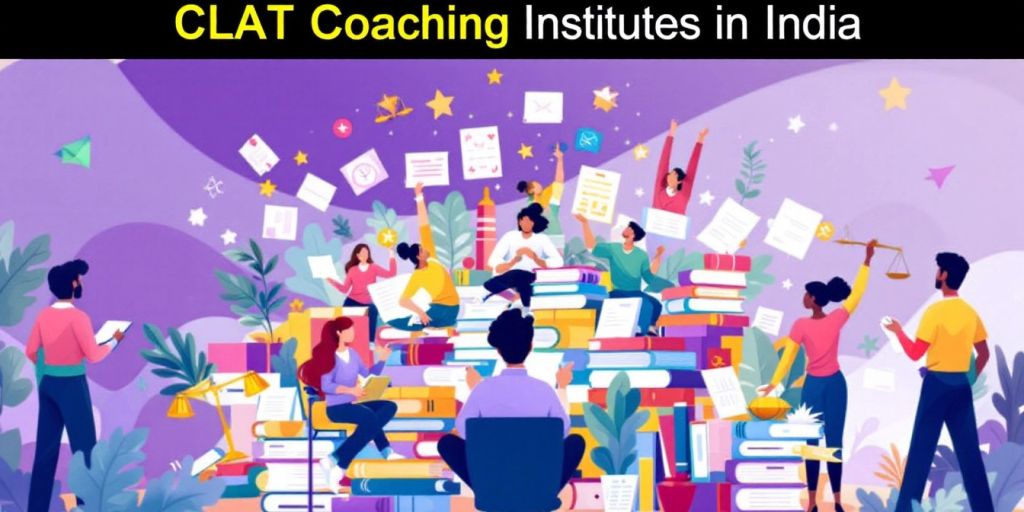The India International University of Legal Education and Research (IIULER) in Goa has joined the NLU Consortium, which is a significant step for the university and law students. This inclusion means that starting with CLAT 2025, IIULER will accept students through the Common Law Admission Test, enhancing its academic offerings and opportunities for aspiring lawyers. This article will explore what this means for students preparing for law school in India, particularly for those aiming for admission in 2025.
Key Takeaways
-
IIULER Goa is now part of the NLU Consortium, making it easier for students to apply for law programs.
-
Starting in 2025, students will use CLAT scores to apply to IIULER, increasing its visibility among law schools.
-
The addition of IIULER means more options for students, leading to greater competition for admissions.
-
IIULER offers a 20% reservation for Goan candidates, making it more accessible for local students.
-
Students should prepare for CLAT 2025 as it will be crucial for admission to IIULER and other law universities.
IIULER Goa’s Entry into the NLU Consortium
The India International University of Legal Education and Research (IIULER) in Goa has recently joined the prestigious Consortium of National Law Universities (NLUs). This significant step marks IIULER as the 25th member of the consortium, enhancing its role in the legal education landscape of India.
Significance of Joining the Consortium
Joining the NLU Consortium is a major milestone for IIULER. It allows the university to participate in the Common Law Admission Test (CLAT), which is a crucial entrance exam for aspiring law students. This inclusion not only broadens the university’s reach but also elevates its academic standards.
Impact on IIULER’s Academic Reputation
With this new status, IIULER is expected to improve its academic reputation significantly. Being part of the consortium means that the university will now be recognized alongside other top law schools in India, which can attract more talented students and faculty.
Role of the Bar Council of India
The Bar Council of India (BCI) plays a vital role in this development. As the governing body for legal education in India, the BCI’s support for IIULER’s inclusion in the consortium underscores its commitment to enhancing legal education across the country. This partnership is expected to foster better educational practices and standards in law schools.
The inclusion of IIULER in the NLU Consortium is a game-changer for legal education in Goa, providing students with more opportunities and resources.
In summary, IIULER Goa’s entry into the NLU Consortium is a pivotal moment for the university and its students, promising a brighter future for legal education in the region.
Understanding the CLAT 2025 Examination
Exam Structure and Format
The Common Law Admission Test (CLAT) is a crucial exam for students aspiring to enter law schools in India. The exam consists of 120 multiple-choice questions that cover various subjects. The test is designed to assess candidates’ skills in areas such as:
-
English including comprehension
-
Current affairs and general knowledge
-
Legal reasoning
-
Logical reasoning
-
Quantitative techniques (Math)
The total duration of the exam is two hours, and it is conducted in a pen-and-paper format.
Eligibility Criteria for Aspirants
To be eligible for CLAT 2025, candidates must meet the following criteria:
-
Undergraduate Courses: Candidates should have completed their Senior Secondary School (10+2) with at least 45% marks (40% for SC/ST candidates).
-
Postgraduate Courses: Candidates must hold an LL.B. degree or an equivalent with a minimum of 50% marks (45% for SC/ST candidates).
-
There is no upper age limit for candidates appearing for the UG program.
Key Dates and Deadlines
The timeline for CLAT 2025 is essential for candidates to keep track of. Here are some important dates:
-
Exam Date: December 1, 2024
-
Admit Card Release: Expected around November 15, 2024
-
Counseling Registration: Opens in December 2024 or January 2025
Staying informed about the CLAT 2025 notification details is crucial for all aspirants. This includes understanding reservation policies and recent updates aimed at improving the exam format.
In summary, the CLAT 2025 examination is a significant step for law aspirants, and understanding its structure, eligibility, and key dates is vital for success.
Implications for Law Aspirants
Increased Competition Among Candidates
With IIULER Goa joining the NLU Consortium, the competition for law aspirants is set to intensify. This inclusion means that more candidates will be vying for limited seats in prestigious law programs. As a result, students must prepare thoroughly to stand out in the upcoming CLAT 2025.
Opportunities for Diverse Law Programs
The entry of IIULER Goa into the consortium opens up new opportunities for students. They can now access a wider range of law programs that cater to various interests, such as:
-
Environmental Law
-
International Law
-
Corporate Law
This diversity allows students to tailor their education according to their career aspirations.
Impact on Admission Strategies
As the landscape of law admissions changes, aspirants will need to rethink their strategies. Here are some key points to consider:
-
Research: Understand the unique offerings of IIULER Goa and other NLUs.
-
Preparation: Focus on the CLAT syllabus and practice extensively.
-
Networking: Engage with current students and alumni to gain insights into the admission process.
The inclusion of IIULER Goa in the NLU Consortium signifies a shift in legal education, making it essential for aspirants to adapt to these changes.
IIULER Goa’s Unique Offerings
Specialized Law Programs Available
IIULER Goa offers a variety of specialized law programs that cater to the diverse interests of law students. These programs include:
-
Bachelor of Arts and Bachelor of Laws (BA LLB)
-
Master of Laws (LLM)
-
Diploma courses in various legal fields
These programs are designed to provide students with a comprehensive understanding of legal principles and practices, preparing them for successful careers in law.
Reservation Policies for Goan Candidates
One of the notable features of IIULER Goa is its 20% reservation policy for Goan candidates. This initiative aims to promote local talent and ensure that students from Goa have better access to quality legal education. This policy reflects the university’s commitment to supporting the local community and fostering legal education in the region.
Collaborations with International Institutions
IIULER Goa is actively pursuing collaborations with various international institutions. These partnerships are aimed at enhancing the academic experience for students by providing:
-
Exchange programs
-
Joint research initiatives
-
Opportunities for internships abroad
Such collaborations not only enrich the curriculum but also prepare students for a global legal landscape.
In summary, IIULER Goa’s unique offerings, including specialized programs, reservation policies, and international collaborations, position it as a promising choice for aspiring law students.
The Role of the NLU Consortium
History and Formation of the Consortium
The Consortium of National Law Universities (NLUs) was established on August 19, 2017. Its main goal is to improve the quality of legal education in India. The consortium was formed to help coordinate efforts among various National Law Schools, ensuring they meet high standards in legal education.
Objectives and Goals
The consortium has several key objectives:
-
Enhance legal education across member institutions.
-
Promote collaboration among NLUs for better resource sharing.
-
Establish uniform policies for admissions and curriculum.
Current Member Universities
As of now, the consortium includes 25 NLUs, with IIULER Goa being the latest addition. This membership allows IIULER to participate in the Common Law Admission Test (CLAT), which is crucial for aspiring law students.
The NLU Consortium aims to create a unified platform for legal education, ensuring that all member universities uphold the highest standards.
In summary, the NLU Consortium plays a vital role in shaping the future of legal education in India, making it more accessible and standardized for students across the country.
Preparing for CLAT 2025
Study Resources and Materials
To excel in the CLAT 2025, candidates should utilize a variety of study resources. Here are some recommended materials:
-
Official CLAT Syllabus: Familiarize yourself with the topics covered in the exam.
-
Reference Books: Use books specifically designed for CLAT preparation.
-
Online Courses: Consider enrolling in online courses that offer structured learning.
Tips from Successful Candidates
Learning from those who have succeeded can provide valuable insights. Here are some tips:
-
Create a Study Schedule: Plan your study time effectively.
-
Practice Regularly: Consistent practice can improve your speed and accuracy.
-
Stay Updated: Keep abreast of current affairs, as they are crucial for the exam.
Mock Tests and Practice Exams
Taking mock tests is essential for preparation. They help in:
-
Understanding Exam Format: Get familiar with the structure of the exam.
-
Identifying Weak Areas: Focus on areas that need improvement.
-
Time Management: Learn to manage your time effectively during the exam.
Preparing for CLAT 2025 requires dedication and a strategic approach. Utilizing the right resources and practicing consistently can significantly enhance your chances of success.
Additionally, candidates should stay informed about the latest updates regarding the CLAT 2025 counseling process, as it is crucial for navigating the admissions effectively.
The Future of Legal Education in India
Trends in Law School Admissions
The landscape of legal education in India is evolving rapidly. The inclusion of IIULER Goa in the NLU Consortium marks a significant shift in how law schools operate and attract students. This change is expected to influence admissions processes across the country, making them more competitive and standardized.
Innovations in Legal Curriculum
Legal education is not just about theory; it is increasingly focusing on practical skills. Many law schools are now incorporating experiential learning into their curricula. This includes:
-
Internships with law firms and NGOs
-
Clinical programs that allow students to work on real cases
-
Workshops with legal professionals to enhance practical skills
The Growing Importance of CLAT
As more institutions join the NLU Consortium, the Common Law Admission Test (CLAT) is becoming the primary gateway for aspiring law students. The number of candidates taking the exam is expected to rise significantly, leading to:
-
Increased competition among candidates
-
A greater emphasis on preparation and study resources
-
More diverse applicant pools from various educational backgrounds
The future of legal education in India hinges on adapting to global standards while maintaining local relevance. This balance is crucial for producing competent legal professionals who can navigate complex legal landscapes.
In summary, the future of legal education in India is bright, with transformative changes on the horizon. As institutions like IIULER Goa join the NLU Consortium, they will play a pivotal role in shaping the next generation of legal professionals.
IIULER Goa’s Strategic Vision

Long-term Goals and Objectives
The India International University of Legal Education and Research (IIULER) in Goa has set ambitious long-term goals to enhance its position in legal education. These goals include:
-
Establishing a robust academic framework that aligns with global standards.
-
Expanding its outreach to attract a diverse student body.
-
Fostering partnerships with international institutions to enhance educational quality.
Plans for Expansion and Growth
IIULER aims to grow significantly in the coming years. The university plans to:
-
Introduce new specialized law programs that cater to emerging legal fields.
-
Increase its infrastructure to support a larger student population.
-
Enhance research facilities to promote innovative legal studies.
Community Engagement Initiatives
Engaging with the local community is a priority for IIULER. The university is committed to:
-
Organizing legal awareness programs for the public.
-
Collaborating with local organizations to provide legal aid services.
-
Encouraging students to participate in community service projects.
IIULER’s strategic vision reflects its commitment to becoming a leading institution in legal education, ensuring that it not only meets the needs of its students but also contributes positively to society.
Comparing IIULER Goa with Other NLUs
Academic Strengths and Weaknesses
IIULER Goa, as a new member of the NLU Consortium, brings unique strengths to the table. Its focus on practical legal education sets it apart from many established NLUs. However, it still faces challenges in building a robust reputation compared to older institutions like NLSIU and NALSAR, which have a long history of academic excellence.
Student Life and Campus Facilities
When comparing student life, IIULER Goa offers a vibrant campus experience with a focus on community engagement. The facilities, while modern, may not yet match the extensive resources available at more established NLUs. Here are some key points:
-
Diverse student activities promoting legal awareness.
-
Modern infrastructure with essential amenities.
-
Community engagement initiatives that enhance student experience.
Alumni Success Stories
The success of alumni can significantly influence a law school’s reputation. While IIULER is still building its alumni network, it aims to create pathways for its graduates to excel in various legal fields. Noteworthy is the potential for future success stories as the institution grows and develops its programs.
IIULER Goa’s inclusion in the NLU Consortium marks a significant step towards enhancing its academic offerings and reputation in the legal education landscape of India.
In summary, while IIULER Goa has its strengths, it must continue to evolve and compete with established NLUs to attract top talent and build a strong legacy in legal education.
Navigating the CLAT Counseling Process

How to Rank Your NLU Preferences
When it comes to the CLAT counseling process, ranking your preferences for National Law Universities (NLUs) is crucial. Here are some steps to help you:
-
Research each NLU’s offerings, including programs and faculty.
-
Consider the location and campus facilities of each university.
-
Think about the reputation and placement records of the NLUs.
Understanding the Seat Allocation System
The seat allocation system is based on your CLAT rank and the preferences you set. Here’s how it works:
-
Candidates fill out a preference list during the counseling registration.
-
Seats are allocated based on the rank and preferences submitted.
-
If a candidate does not get their top choice, they may be offered a seat in a lower-ranked NLU.
Tips for a Successful Counseling Experience
To ensure a smooth counseling experience, keep these tips in mind:
-
Stay updated on important dates and announcements from the CLAT consortium.
-
Prepare all necessary documents in advance, including your admit card and identification.
-
Be flexible with your choices, as the competition can be intense.
The CLAT counseling process is a vital step for aspiring law students, as it determines their future in legal education. Understanding the process can unlock opportunities for a successful career in law.
The Impact of IIULER’s Inclusion on CLAT
Changes in Exam Dynamics
The addition of IIULER Goa to the NLU Consortium will significantly alter the landscape of the CLAT examination. With IIULER now participating, the number of candidates vying for limited seats in prestigious law schools will increase. This means that students must prepare even more thoroughly to stand out in a competitive environment. The expected rise in applicants could lead to a more rigorous selection process, making it essential for aspirants to focus on their preparation strategies.
Feedback from Current Students
Current students from other NLUs have expressed mixed feelings about the inclusion of IIULER. Some believe it will enhance the overall quality of legal education in India, while others worry about the increased competition. Here are some common sentiments:
-
Excitement about more diverse law programs.
-
Concerns regarding the rising cut-off scores for admissions.
-
Hope that IIULER will bring fresh perspectives to legal education.
Expectations from Future Batches
As IIULER joins the ranks of established NLUs, future batches can expect:
-
Enhanced academic offerings that cater to a wider range of legal interests.
-
Increased collaboration with other NLUs, leading to shared resources and opportunities.
-
Greater emphasis on practical training and internships, preparing students for real-world legal challenges.
The inclusion of IIULER Goa in the NLU Consortium marks a pivotal moment for legal education in India, promising to reshape the future for aspiring law students.
Legal Education and Career Prospects

Career Paths for Law Graduates
Legal education opens up a variety of career paths for graduates. Many law graduates find opportunities in diverse fields, including:
-
Corporate Law: Working with businesses on legal matters.
-
Public Service: Engaging in government roles or non-profit organizations.
-
Emerging Fields: Exploring areas like technology law and environmental law.
The Role of Internships and Clerkships
Internships and clerkships are crucial for law students. They provide hands-on experience and help students build connections in the legal field. Here are some benefits:
-
Real-World Experience: Students apply their knowledge in practical settings.
-
Networking Opportunities: Building relationships with professionals can lead to job offers.
-
Skill Development: Internships help students develop essential skills for their future careers.
Networking Opportunities in the Legal Field
Networking is vital for law graduates. It can lead to job opportunities and collaborations. Here are some effective ways to network:
-
Attend legal seminars and workshops.
-
Join professional organizations related to law.
-
Connect with alumni from your law school.
In summary, the legal field offers numerous career opportunities for graduates. With the right education and experience, students can pursue fulfilling careers in various sectors, including international career opportunities and public service roles. The importance of internships and networking cannot be overstated, as they play a significant role in shaping a successful legal career.
Legal education opens many doors for your future. With the right guidance and resources, you can excel in your law entrance exams and build a successful career in law. Don’t miss out on the chance to enhance your skills and knowledge. Visit our website today to learn more about our courses and how we can help you succeed!
Conclusion
In summary, IIULER’s entry into the NLU Consortium is a significant step for law students in India. This change means that starting in 2025, students will have a new option for their legal education. They can now apply to IIULER through the CLAT exam, which is a well-known test for law schools. This addition not only increases the number of choices for aspiring lawyers but also helps improve the quality of legal education in the country. With IIULER’s commitment to providing quality education and a special reservation for local students, the future looks bright for those looking to study law in Goa.
Frequently Asked Questions
What is IIULER Goa’s new role in the NLU Consortium?
IIULER Goa has joined the NLU Consortium, becoming the 25th member. This allows them to participate in the Common Law Admission Test (CLAT) starting in 2025.
How does joining the NLU Consortium benefit IIULER Goa?
Joining the consortium enhances IIULER’s reputation and provides students access to a wider range of legal education opportunities.
What is CLAT and why is it important?
CLAT, or Common Law Admission Test, is a national entrance exam for law schools in India. It is crucial for students wanting to gain admission to top law universities.
Are there any special reservations for Goan students at IIULER?
Yes, IIULER Goa offers a 20% reservation for candidates from Goa.
What are the eligibility criteria for CLAT?
To be eligible for CLAT, candidates must have completed their 12th grade with at least 45% marks (40% for SC/ST candidates). There is no upper age limit.
When will CLAT 2025 take place?
CLAT 2025 is scheduled for December 1, 2024.
How can students prepare for CLAT?
Students can prepare for CLAT by using study resources, practicing with mock tests, and reviewing tips from successful candidates.
What is the significance of IIULER’s inclusion in the NLU Consortium for law aspirants?
IIULER’s inclusion increases competition and provides more options for students, making legal education more diverse.






































